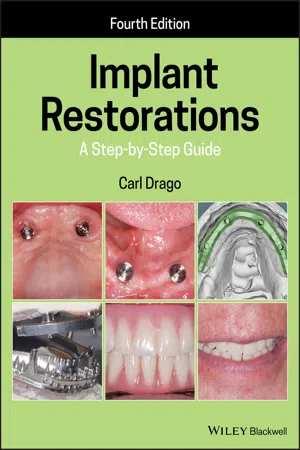
- English
- ePUB (mobile friendly)
- Available on iOS & Android
About This Book
The fourth edition of Implant Restorations: A Step-by-Step Guide provides a wealth of updated and expanded coverage on detailed procedures for restoring dental implants. Focusing on the most common treatment scenarios, it offers concise literature reviews for each chapter and easy-to-follow descriptions of the techniques, along with high-quality clinical photographs demonstrating each step.
Comprehensive throughout, this practical guide begins with introductory information on incorporating implant restorative dentistry in clinical practice. It covers diagnosis and treatment planning and digital dentistry, and addresses advances in cone beam computerized tomography (CBCT), treatment planning software, computer generated surgical guides, rapid prototype printing and impression-less implant restorative treatments, intra-oral scanning, laser sintering, and printing/milling polymer materials. Record-keeping, patient compliance, hygiene regimes, and follow-up are also covered.
- Provides an accessible step-by-step guide to commonly encountered treatment scenarios, describing procedures and techniques in an easy-to-follow, highly illustrated format
- Offers new chapters on diagnosis and treatment planning and digital dentistry
- Covers advances in cone beam computerized tomography (CBCT), computer generated surgical guides, intra-oral scanning, laser sintering, and more
An excellent and accessible guide on a burgeoning subject in modern dental practice by one of its most experienced clinicians, Implant Restorations: A Step-by-Step Guide, Fourth Edition will appeal to prosthodontists, general dentists, implant surgeons, dental students, dental assistants, hygienists, and dental laboratory technicians.
Frequently asked questions
Information
1
Introduction to Implant Dentistry
Introduction
Purpose of Textbook
Table of contents
- Cover
- Table of Contents
- List of Contributors
- Foreword
- Preface
- Acknowledgments
- 1 Introduction to Implant Dentistry
- 2 Implants and Implant Restorative Components
- 3 Diagnosis and Treatment Planning in Implant Restorative Dentistry
- 4 Treatment of Edentulous Mandibular Patients
- 5 Replacement of Single Teeth with CAD/CAM Implant Restorations
- 6 Fixed Dental Prostheses
- 7 Accelerated Treatment Protocol of a Patient with Edentulous Jaws and CAD/CAM Titanium Framework/Fixed Hybrid Prostheses
- 8 Treatment of Edentulous Patients with Immediate Occlusal Loading
- 9 Treatment of Edentulous Patients with Immediate Occlusal Loading
- 10 Treatment of Partially Edentulous Patients with Immediate Non‐Occlusal Loading Protocols (Intraoral Scanning, CAD/CAM Abutment, and Definitive Maxillary Central Incisor Restoration; Co‐Axis Implant and Restoration)
- 11 Computed Tomography (CT) Guided Surgery/Immediate Occlusal Loading with Full‐Arch Prostheses in Edentulous Patients
- 12 Guidelines and Maintenance Procedures for Fixed, Full‐Arch, Implant‐Retained Prostheses
- Index
- End User License Agreement